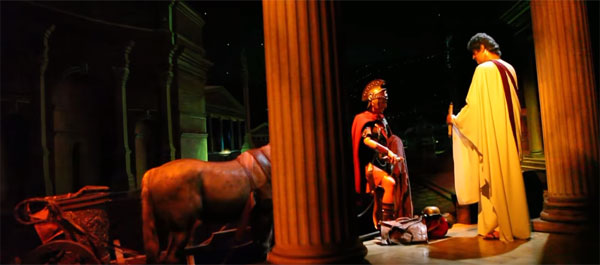
One of my favorite parts of Spaceship Earth as a kid appears right in the middle of the ascent. It is a simple bit of animation during the Roman Empire scene. The forefront of the scene depicts Roman men having a conversation next to a chariot between large columns. My attention centers on something else: a repeated image of a chariot traveling away from us in the background. This film projection of an animated chariot exemplifies the larger system of roads described by the narrator. As Jeremy Irons explains, all roads led to Rome. This effective scene represents the essence of how Spaceship Earth succeeded from the start.
The animated chariot is hardly the most impressive technology in Spaceship Earth; it actually looks a little cheap. What makes it work is how it differs from the physical scenes that dominate the attraction. It’s also a bit silly to see the image next to a serious presentation of Rome. These small touches help to make the best Disney attractions click. There are SO many of these in the original EPCOT Center attractions. Slow-moving Omnimover rides can’t take themselves too seriously. The creativity of this choice sticks with me years after my first experience.
We’ve reached an iconic moment in our journey through Spaceship Earth, Scene by Scene. Throughout the attraction’s history, the trip to Ancient Rome and burning of knowledge has been one of the most significant moments. There were major changes in the 2007 version, but it also includes an odd script addition. The art direction remains striking, so it’s a strong update overall. Let’s continue our voyage through Spaceship Earth and dive into the history of this classic scene.
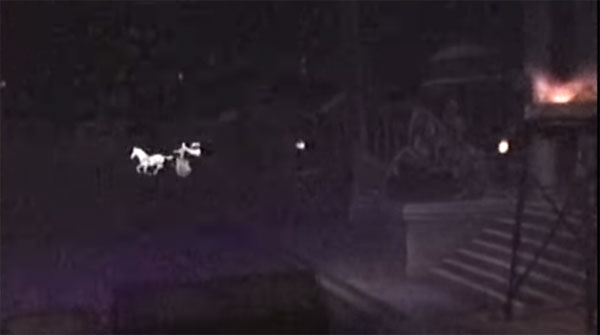
Glorious Rome
Before I talk about the 2007 changes, let’s go back to the ancient times of the original Spaceship Earth. It’s no surprise that the language is more aloof than later versions. In this particular case, Vic Perrin’s narration elegantly describes the rise and fall of Rome. It’s wonderfully written and effectively presents this scene. Here is the narration from Perrin:
“North, South, East, and West, all roads lead from Rome, a mighty network reaching across the land, welding far-flung garrisons into a growing empire. Glorious Rome, until consumed by the flames of excess. Imperial Rome, lost in the ashes of darkness.”
This commentary from Perrin spans across two scenes with different connotations. The first effectively describes the growth and power of the Roman Empire. I love the phrase “welding far-flung garrisons” to quickly explain the scope. Cronkite’s narration makes similar points about the system of roads and even uses the phrase “long distance network” to connect to AT&T. It’s not a big change but is more down to Earth. A subtle tonal shift begins the move to connect the Roman Empire to our life. We’ll see a lot more in that regard in 2007.
One thing I did not remember is the more consistent change across each script. Irons does reference the “fastest information highways the world had ever known”. The foundation was already in place for more direct connections from Dench. Irons also gives us the first reference to invaders that destroyed Rome. Instead of citing the “flames of excess”, it is now external forces that eliminated important knowledge. Rome is no longer a cautionary tale. Dench sidesteps this issue entirely and just calls the fall of Rome a “roadblock”. Our learning is lost, but the specific end of this empire really is only a setback for knowledge.
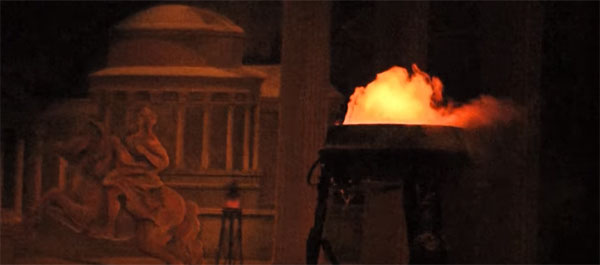
A Closer Look
We pass a large statue of Augustus on our left and a Latin inscription from the first of The Twelve Tables of Roman Law (circa 451 BCE). A toga-clad Roman speaks to a soldier and provides a decree while a horse rests nearby. In earlier versions, we then pass a backdrop of a road and see the chariot mentioned earlier. Art Director Neil Engel was kind enough again to provide great details on the 2007 update. Engel wanted to keep the chariot but was overruled because the 16mm projector image seemed dated. He also believes that the projector sits unused inside Spaceship Earth.
This scene is much better defined in 2007. The lighting allows us to catch an earlier glimpse. The statue remains in place, but the horse and others are sharper. Engel noted that they moved the figures up 14 inches since the bottoms were completed. Both human figures also received new costumes, and they even hid a crushed foot on the Centurion with a rucksack-style prop. This information from Engel reminds me of how much attention to detail is given to each scene during an update. The animation is similar to prior versions, but the small touches to the figures make a huge impact.
Our next stop reveals the burning of Rome, which has always been a convincing scene. It reminds me just how much you can accomplish with a simple smell and effective set design. Engel provided the way they enhanced the burning effects for the latest update. Some leftover charred Phoenician scrolls were added to be part of the ashes in both that scene and the earlier brazier. It’s another clever way to “plus” a scene without a massive change.
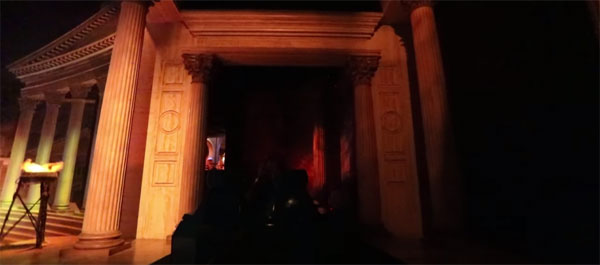
The First World Wide Web
So many things were done right in the Rome scene for the Judi Dench version. The Bruce Broughton music is stunning and offers more subtlety than the 1994 attraction. Beyond the removal of the animated chariot, the rest of the physical changes improve the experience. My only issue is a script concern, and it really boils down to a single modification. Here is the first part of the Dench narration as we pass through Ancient Rome:
“With lessons learned from the Greeks, the Romans create a powerful empire. To move their armies around, they build a system of roads all over the known world. Rome built the first “world wide web,” and it’s leading us into the future.”
While more straightforward than past versions, Dench’s first two lines tell the right story. I just can’t get around connecting Rome to the world wide web. It makes me laugh every time, and I don’t believe that is the purpose. I don’t mind the overall goal to connect Spaceship Earth to a wider audience. Irons’ words also drew the connection, but there was subtlety there. Dench takes her best shot, but there is little she can do with such a clunky line. This is not thanking the Phoenicians; I don’t believe there any t-shirts about Rome and the Internet.
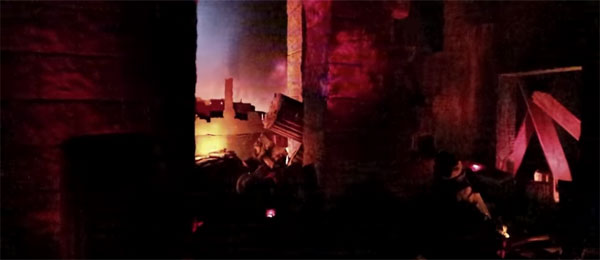
Smooth Transitions
The Rome scene rests in the middle of a particularly strong part of Spaceship Earth. The 2007 updates do a nice job connecting the Greeks and libraries of the Middle East on either side of it. Dench cites lessons learned from the Greeks as we enter Rome, and the fire leads us directly into the following scene. I may disagree with some updates to the script, but I love this part of the attraction. The pace is going to ramp up when we reach the Renaissance and Information Age. The artfully made scenes and relaxing atmosphere here represent the best of what Disney can do.
Next time, books are saved! We also see the first back-up system. My journey through the incredible Spaceship Earth will continue; stay tuned!
Sources: INTERCOT, Martin’s Videos, Mouseplanet, Secret Stories of Walt Disney World by Jim Korkis
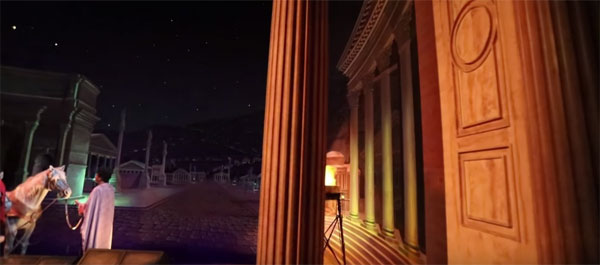
Related Articles: Rome Burned
Spaceship Earth, Scene by Scene: The Theater (and Math) is Born
Five Steps to Enhance Spaceship Earth
Spaceship Earth, Scene by Scene: The Ancient Egyptians
Spaceship Earth, Scene by Scene: Thank the Phoenicians!
This post contains affiliate links. Making any purchase through those links supports this site. See full disclosure.



One thing left out of your discussion is the hills on the background of the Roman scene. Up until the 2007 rehab, there were moving torch lights going up the sides of the hills. Along with the projection chariot, it gave the impression that the Romans were ‘on the move’ along the roads to and from Rome. It’s a minor detail that carried a lot of weight in this scene. I’ve always hoped to see it return every time I’ve ridden SSE since 2007 but I font see it returning in the near future. °o°
Great point. This is the challenge of relying on my memory and fuzzy ride videos. You bring up another perfect example of all the small touches that have made this attraction so convincing. I agree that it’s unlikely to return, and I really hope whatever they update next is up to the same standard.
Great commentary on a powerful scene, and I agree, the world wide web comment is really pushing it. For those who get sentimental for the “Rome burning” smell like I do, I wanted to recommend Demeter Fragrance’s “Bonfire” scent, which is really close. Give yourself a spritz and sing “Tomorrow’s Child” as you cry over the loss of so many great pavilions. https://demeterfragrance.com/bonfire.html
Thanks Melanie! That scent looks interesting; I haven’t purchased anything like it but am sure it would bring up some fond memories.
Sorry to reply so long after everyone seems to have moved on! But…after riding Spaceship Earth 4 times in a row on my first post-Covid visit and also my first trip with a keen awareness that this version has a limited lifespan (not if but when), I am trying to find out what the Roman is saying. Does the conversation translate into English?
I haven’t been able to locate a website with a full translation, but this tribute from Martin’s Videos on YouTube includes the translation along with the scene. Hopefully this helps. Here’s the link: https://www.youtube.com/watch?v=JwmcIklo4ko&t=817.